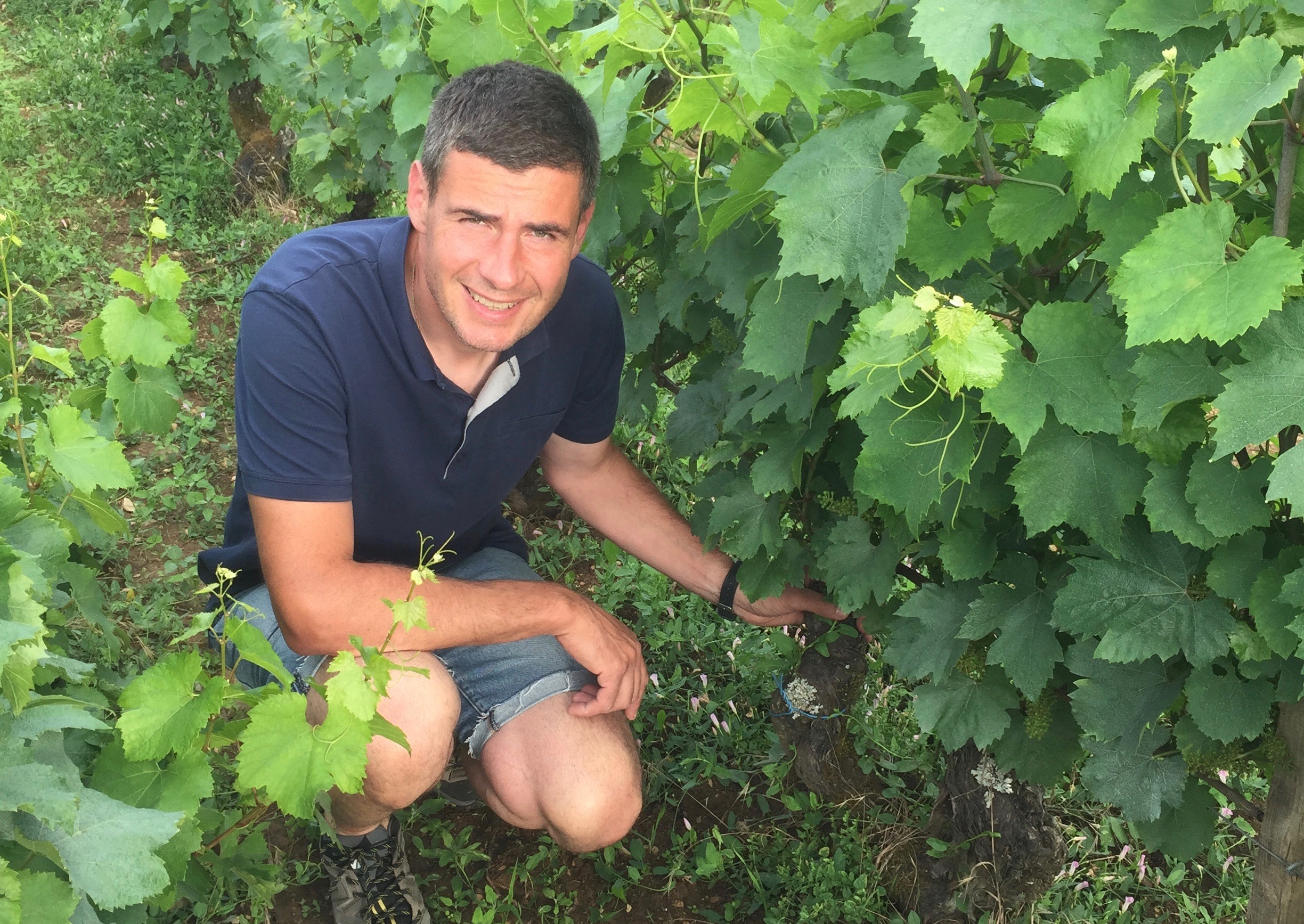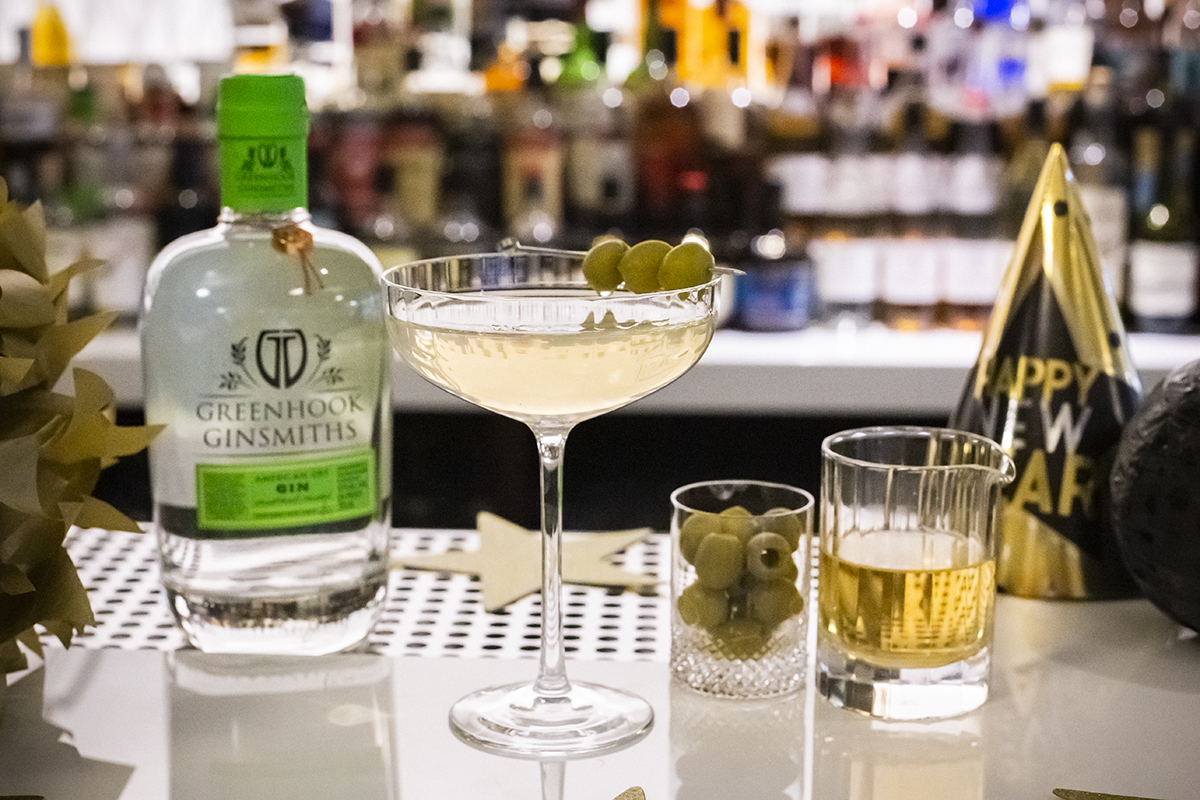For our 3rd Annual “Buon Natale” post, we thought it a perfect opportunity to check in with some of our newest Italian producers to the Skurnik family: BiancaVigna, Benito Ferrara, Torre Raone, and Malvirà. Each producer was kind enough to offer their family’s holiday traditions and favorite recipes, which we are thrilled to share with you.
May these dishes find a happy home on your holiday table!
BiancaVigna of Conegliano Valdobbiadene
Proprietor: Elena Moschetto

Our Christmas lunch is all about tradition! The meal is happily shared with the members of my family and my brother Enrico. We cook one of the most typical Venetian recipe: bollito alla veneta. But it all begins, of course, with a toast of our Conegliano Valdobbiadene DOCG!
In the past, farmers could afford to cook meat only for very special occasions, such as Christmas or weddings, and bollito – with its variety of different meat cuts – was, and still is, considered a very festive celebratory dish. It’s very common in northern Italy but with some important differences from region to region…and even from town to town! The recipe is not very difficult, but what makes the difference is the variety and cuts of the meats and the sauces used in its preparation.
Here, in the province of Treviso, we’re used to accompanying our bollito with a horseradish sauce and salsa verde. Christmas celebration cannot end without a sweet bite and nothing’s better than BiancaVigna Pandoro and Panettone: the first one is stuffed with Prosecco cream whilst the raisins used in the Panettone are dipped in Prosecco for few hours…a real treat for kids and adults alike!
Bollito alla veneta (recipe for 8 people)
- 2.5 lb of beef sirloin
- 2.5 lb of veal brisket
- 1 small veal tongue
- half of a chicken
- 1 musetto (what is commonly known as cotechino)
- celery
- onion
- carrot
- salt
Fill a large pot with cold water. Add salt, celery, onion and carrot, and bring to a boil. Dip the beef sirloin and let it boil slowly with gentle fire for a good hour. Then add the veal brisket, the tongue and the chicken and let it cook for another 2 hours. Fill another pot with cold water and dip the musetto, bringing it to a boil and letting it cook for about 2 hours. Once the meat is well cooked, take it out of the water and drain well. Serve in a large tray with horseradish sauce on the side and salsa verde made with parsley, capers, anchovies, garlic and extra-virgin olive oil.
Benito Ferrara of Campania
Proprietor: Gabriella Ferrara
Christmas dinner traditionally includes Fusilli Avellinesi. The Avellino’s fusillo is a typical part of Irpinia’s gastronomic tradition, rediscovered by Pastificio Graziano and made in its original form. This specialty is the flagship of Pastifico Graziano and is made as both short and long fusillo, made with a slow drying and a traditional bronze-drawn process. We then serve the fusilli with a sauce of stuffed capon (see recipe below).
The Fusilli Avellinesi is then followed by grilled lamb with roasted potatoes and the capon used for the sauce of the pasta mentioned above paired with our Irpinia Aglianico ‘Quattro Confini.’
And there is no way to end our dinner without our favorite local sweets : pastiera napoletana, zeppole di natale & strufoli di natale!
BUON NATALE!
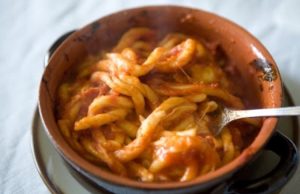
Capon Sauce Recipe
- 1 lb. capon (a type of fattened rooster)
- 2 cups capon stock
- 1/2 cup E.V.O.O
- 2 oz. porcini mushrooms, rinsed, squeezed dry, then coarsely chopped
- 1 carrot, diced
- 3 cloves garlic, diced
- 1 shallot sliced very thin
- 1 tbsp AP flour
- Salt and pepper to taste
Rinse the capon and remove as much fat as possible. Boil the whole capon in water, adding 1 carrot, 1 celery stalk, and salt and pepper. Gently boil for 2 hours, adding 6 sage leaves to the water once it’s boiling. Stain and set aside as 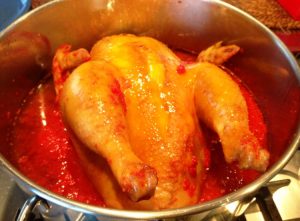 stock. Remove the capon from the pot and allow to cool. Separate the legs and thighs to use for the recipe, saving the breasts for another time.
stock. Remove the capon from the pot and allow to cool. Separate the legs and thighs to use for the recipe, saving the breasts for another time.
Prepare a pasta pot with water and heat over medium. While water is warming, place sliced/shredded capon into large sauté pan with EVOO, diced carrots, and diced garlic. Cook for 3 minutes over medium heat and then add the shallot. Add mushrooms and cook for 5 minutes. Add 3 cups capon stock, stir, and cook for 10-15 minutes. Thicken sauce with flour and allow sauce to simmer for 15-30 minutes. Boil pasta and drain when ready. Toss pasta in capon sauce once both is prepared, allowing the pasta to be fully coated with the capon sauce and enjoy!
Torre Raone of Abruzzo
Proprietor: Dante di Tizio
Abruzzo is a region where tradition is very much felt. Every year, in our family we make ourselves a big Christmas lunch that includes many dishes that are typical of our region.
As a starter, my mother always prepares a classic platter of cured meats and local cheeses. The next dish is a must-have for Christmas in Abruzzo: the capon broth accompanied by thistles and beaten eggs.
After the broth, it’s time for lasagna! My mother makes her lasagna with artichokes and mozzarella, as this is a favorite of both my father and me.
After the first dishes, we move on to the mains, as our tradition dictates. Roast lamb is served, accompanied by a side dish of mushrooms and peas. Another side dish that is never missing at home is a salad from our home garden. With this course, we always enjoy a 3-liter of our Montepulciano d’Abruzzo!
After some tangerines to refresh our palates, we finally arrive to the desserts! The panettone obviously cannot be missed, along with our two typical Christmas sweets: The “cacionetti,” which are short pastry ravioli filled with jam and Nutella and finally “the parrozzo,” which is a panettone Abruzzese made with almond flour and covered with chocolate!
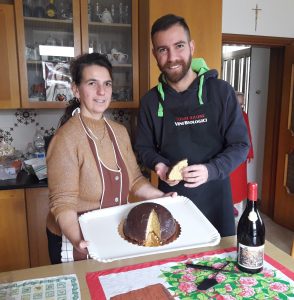
Parrozzo Recipe:
- 5 eggs
- 3/4 cup sugar
- 1 cup finely chopped almonds
- 1/4 cup semolina
- 1 lemon
For the Filling
- 200 grams dark chocolate
- 1 cup milk
- 2 tbsp butter
Whip egg whites until stiff. Slowly add the sugar and fold or mix on a low speed. Add the finely chopped almonds, the semolina and the lemon juice (or zest) to the mixture and continue to mix until all ingredients are evenly distributed. Grease a parrozzo mold and pour the mixture. Bake in ventilated oven for approximately 1 hour and 30 minutes at a temperature of about 130/140 degrees. Once baked, allow to cool and then remove from the mold.
For the filling, gently melt 200 grams dark chocolate in a non-stick pan (or double boiler) with 1 cup milk and two tablespoons of butter. Brush the lower part of the parrozzo with chocolate until fully covered and allow the chocolate to solidify. Finally, turn the parrozzo right side up and cover the upper part in the same way, trying to get a smooth surface. Allow the chocolate to solidify and store in a cool place to prevent the chocolate from melting.
Malvirà of Roero
Proprietors: Roberto and Massimo Damonte
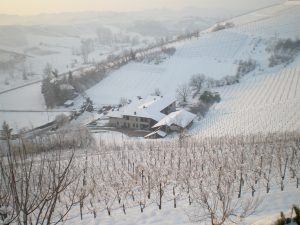 Every year, when the whole Damonte family reunites for Christmas (5 siblings, which means 5 different families), we have a classic Italian dessert: panettone.
Every year, when the whole Damonte family reunites for Christmas (5 siblings, which means 5 different families), we have a classic Italian dessert: panettone.
But the panettone is not the special part of the dessert; rather, the cream we use to soak it in is. We say ‘Bagnè’l panatun’ in Piedmontese. It is an important recipe that is passed on from one generation to the next and makes any panettone especially delicious!
This cream came to our family through our mother Lucia, born in 1926, who unfortunately died just after the Christmas holidays of 2016 at the age of 91 years. She came from a very large peasant family who lived a hundred meters from the family of our father, Giuseppe.
Our mother was the third child, along with her twin, who unfortunately died during birth. Her older sister was born in the USA and was constantly in need of care; the family had to work hard to help this less fortunate sister. This situation brought our mother, just after finishing elementary school, to go help a wealthy Turin family where she would assist the cook to prepare meals and the other servants to manage the house.
It was in this Torinese environment, a city of kings and good taste, already famous for its literary cafés, for the processing of chocolate, and the famous Bicerin, which is a hot drink based on rum, chocolate, coffee and whipped cream. This is where our mother Lucia discovered the preparation of the Christmas mascarpone cream.
The day before Christmas, we all participated in the preparation of the unavoidable agnolotti, pasta stuffed with three meats, a small addition of vegetables and parmesan. I loved to turn the crank of the machine to pull the dough out, but most of the time I was demoted from a pasta machine clerk to a simple agnolotti separator. The preparation of mascarpone cream was the last step.
The rule was to prepare a very small amount just before the Christmas dinner started because it tended to separate. The youngest of the family would usually beat the egg whites, but we would take turns because after a while our little arms would get tired. While our mother wisely whipped the various preparations until the right creamy consistency was achieved, usually those who beat the eggs with sugar also had to protect the preparation from us little ones because we already wanted to taste this first draft of cream, usually trying to dip a finger into the preparation bowl.
The main aroma was given by a couple of tablespoons of Cognac, according to the recipe from Turin learned by our mother, but we also make a variation using an espresso ristretto (very concentrated) instead of Cognac. Both preparations are excellent to accompany a good panettone, with the advantage that if the panettone is not of excellent quality and looks a little ‘dry,’ the cream definitely improves it.
The end of the meal consists precisely of dipping the slice of panettone in this cream, just like the croissant in the cappuccino.
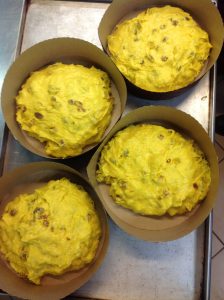
Bagnè’l Panatun Recipe:
- 4 eggs
- 4 spoons of sugar
- 1 caffè ristretto
- 250gr mascarpone
1. Beat the egg yolks with the sugar until it gets fluffy and light.
2. Add the coffee, then the mascarpone, little by little, always stirring.
3. Stir until you obtain a thick and smooth cream.
4. Finally, fold the beaten fluffy egg whites to the cream.
This cream is served cold in a cup, next to the panettone. Pair with our Arneis Late Harvest ‘Renesium’ and enjoy!
We wish you all a wonderful holiday filled with merriment, great food, and lots of delicious Italian wine, crafting traditions of your own, both new and old. Salute!





